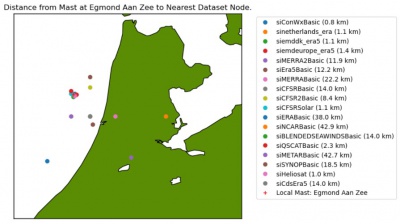EMD-API - Climate Data Access: Difference between revisions
| Line 24: | Line 24: | ||
Install the required packages needed in order to do data-science and use the examples provided within the jupyter notebooks: | Install the required packages needed in order to do data-science and use the examples provided within the jupyter notebooks: | ||
<pre> | <pre> | ||
conda install pandas numpy matplotlib basemap basemap-data-hires jupyter ipykernel | conda install pandas=1.1.0 numpy=1.19.1 matplotlib=3.3.1 | ||
conda install basemap=1.2.2 basemap-data-hires=1.2.2 | |||
conda install jupyter=1.0.0 ipykernel=7.17.0 | |||
</pre> | </pre> | ||
Revision as of 17:01, 7 September 2020
Origin and Purpose

EMDAPI is a software library from EMD International. It delivers a unified interface to a wide range of climate data. EMDAPI helps consultants, analysts and scientists working with high-resolution climate data in achieving their goals in an efficient way. It has the following key-features:
- Instant data delivery: All datasets within the EMDAPI are ready processed and requests are served within seconds or minutes
- 40+ climate datasets: EMDAPI provides access more than 40 of the best climate datasets and allows access to more than 1Pb of data.
- Unified interface: The unified interface which allows for integration to internal processes and tools - and also very efficient uncertainty analysis with gigabytes of data easily accessed.
- Trusted datasets: EMDAPI builds upon the trusted data-bases and data-sources that have been used through the online-data services in windPRO for more than a decade.
- Built on open standards: EMDAPI is a REST based service that implements the OpenAPI standard].
- Available from any development tool: Access to the climate databases is available from your preferred development platform - C#, R, python, html, java, php, scala and swift. Just use the OpenAPI tools to generate the client software for your preferred platform.
Access
The API is currently (August 2020) in beta-release. To see more documentation and to access the data-services, please visit the API through the following URL:
Python - Installation and Test

The simplest way to use the EMDAPI with python is to install the client software in a virtual environment. If you are using CONDA or MINICONDA, we recommend that you create a new virtual environment and use a recent 3.x version of python. When the virtual environment is created, then activate the environment.
conda create -n emdapi python=3.8.5 conda activate emdapi
Install the required packages needed in order to do data-science and use the examples provided within the jupyter notebooks:
conda install pandas=1.1.0 numpy=1.19.1 matplotlib=3.3.1 conda install basemap=1.2.2 basemap-data-hires=1.2.2 conda install jupyter=1.0.0 ipykernel=7.17.0
Download the zipped-file holding the OpenAPI python client. Unpack the file and install it within your virtual environment:
python setup.py install
Ensure that the python-kernel is available from the jupyter-notebook:
python -m ipykernel install --user --name=emdapi
Download and unpack a few jupyter notebook examples here and then give the installation a test-drive using the jupyter notebooks provided
jupyter notebook
Client Software Other Languages and Tools
A list of client software generated from the swagger editor is found below.
If you want to generate the client libries yourself - or use other tool than mentioned above - one possible process is to: